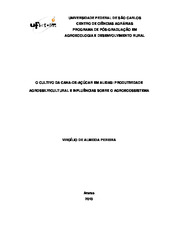| dc.contributor.author | Pereira, Virgílio de Almeida | |
| dc.date.accessioned | 2016-06-02T18:57:49Z | |
| dc.date.available | 2014-02-26 | |
| dc.date.available | 2016-06-02T18:57:49Z | |
| dc.date.issued | 2013-12-04 | |
| dc.identifier.citation | PEREIRA, Virgílio de Almeida. Sugarcane farming in alley cropping system: agroforestry productivity and influences in the agroecosystem. 2013. 174 f. Dissertação (Mestrado em Ciências Agrárias) - Universidade Federal de São Carlos, São Carlos, 2013. | por |
| dc.identifier.uri | https://repositorio.ufscar.br/handle/ufscar/166 | |
| dc.description.abstract | Sugarcane plantations are increasing in Brazil motivated by the demand of the sugar industry and the energetic sector. Sugarcane monocultures simplify the landscape and disconnect natural ecosystems. The inclusion of native trees in the canebrake, changing the matrices into an alley cropping system, is a new proposal that consider the environment beyond production. In order to assess the environmental effects in agroforestry was raised sugarcane productivity and development of trees in three crops (2009/10, 2010/11 and 2011/12), as well as the timber volume and carbon sequestration produced by the system at the end of the year 2012 and a bird survey during 2011 and 2012 in an experimental area of 1,957 hectares. Was found orderly development of tree species. Schizolobium parahyba present a significant mortality, but had the largest wood production thus coming to the same conclusion in relation to carbon sequestration, which are 3 times those of the Handroanthus spp. and 2 times the Cedrela fissilis. There was no change in the sugarcane productivity related to the distance line planting was the alley, with only a drop productivity in the range of 58 m cultivation. Birds are important bioindicators; trees contributed to the increased diversity of birds, being Schizolobium parahyba the arboreal species of most relevant importance. The spacing between alleys with the greatest diversity of birds was to 29 m. It is concluded that it is technically possible deployment agroecosystem proposed, without agronomic production damage of cane sugar; the 2 smaller bands cultivation (29 m and 43.5 m) are the most suitable; among tree species Schizolobium parahyba was the one with the best results in the short term, since the issue of mortality could be remedied with proper management or replanting. | eng |
| dc.description.sponsorship | Universidade Federal de Sao Carlos | |
| dc.format | application/pdf | por |
| dc.language | por | por |
| dc.publisher | Universidade Federal de São Carlos | por |
| dc.rights | Acesso Aberto | por |
| dc.subject | Cana-de-açúcar | por |
| dc.subject | Sistema agroflorestal | por |
| dc.subject | Aleias | por |
| dc.subject | Agroforestry | eng |
| dc.subject | Alley cropping systems | eng |
| dc.subject | Canebrake | eng |
| dc.title | O cultivo da cana-de-açúcar em aleias: produtividade agrossilvicultural e influências sobre o agroecossistema | por |
| dc.title.alternative | Sugarcane farming in alley cropping system: agroforestry productivity and influences in the agroecosystem | eng |
| dc.type | Dissertação | por |
| dc.contributor.advisor1 | Margarido, Luiz Antonio Correia | |
| dc.contributor.advisor1Lattes | http://lattes.cnpq.br/5685663057214334 | por |
| dc.description.resumo | O plantio de cana-de-açúcar está em franca expansão no Brasil motivado pela demanda do setor sucroenergético. Os canaviais em matrizes monoculturais simplificam a paisagem e desconectam ecossistemas naturais. A inserção de aleias com árvores nativas em canavial é uma nova proposta que contempla o ambiente além da produção. Com o objetivo de avaliar os efeitos ambientais e a produtividade agrossilvicultural nesse sistema agroflorestal, foram levantados em uma área experimental de 1,957 hectares, o rendimento da cana-de-açúcar e o desenvolvimento das árvores constituintes das aleias em 3 safras (2009/10, 2010/11 e 2011/12); bem como o volume de madeira produzido e a fixação de carbono pelo sistema ao final do ano de 2012; e a dinâmica da avifauna durante os anos de 2011 e 2012. Constatou-se um desenvolvimento regular das espécies arbóreas, observando grande taxa de mortalidade do guapuruvu (60%). Foi possível constatar a maior produção de madeira pelo guapuruvu, consequentemente chegando aos mesmos resultados em relação à fixação de carbono, sendo estes 3 vezes superiores aos do ipê e 2 vezes ao cedro. A produtividade da cana não esteve relacionada com a distância entre a linha de plantio e a aleia, apresentando queda apenas na faixa de cultivo de 58 m. A avifauna foi considerada um bioindicador consistente; o guapuruvu foi a espécie florestal com maior importância para o aumento da diversidade de aves e o espaçamento entre aleias com a maior riqueza foi o de 29 m. Conclui-se que é tecnicamente possível a implantação do agrossistema proposto, sem prejuízo agronômico da produção da cana-de-açúcar, sendo as 2 menores faixas de cultivo (29 e 43,5 m) as mais propícias e o guapuruvu a espécie arbórea com melhores resultados em curto prazo, desde que a questão da mortalidade seja sanada com replantio ou manejo adequado. | por |
| dc.publisher.country | BR | por |
| dc.publisher.initials | UFSCar | por |
| dc.publisher.program | Programa de Pós-Graduação em Agroecologia e Desenvolvimento Rural - PPGADR-Ar | por |
| dc.subject.cnpq | CIENCIAS AGRARIAS | por |
| dc.contributor.authorlattes | http://lattes.cnpq.br/9761906263634624 | por |
